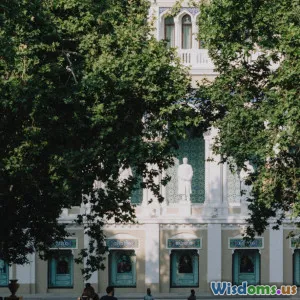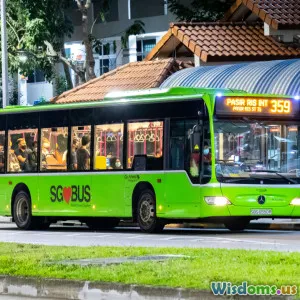
Making Buses Cool Again Innovative Transport Revamps in Berlin
9 min read Discover how Berlin is transforming its bus system with cutting-edge technology and design to make public transport appealing and efficient again. (0 Reviews)
Making Buses Cool Again: Innovative Transport Revamps in Berlin
Introduction
For decades, buses around the globe have been considered the less glamorous, often less desirable mode of urban transport. Crowded, slow, and frequently outdated, bus systems have struggled to captivate riders in many cities — including Berlin, a city celebrated for its efficient and iconic public transit. But what if the bus could be cool again? That is the ambitious goal Berlin is now pursuing.
With climate concerns escalating and urban congestion becoming untenable, Berlin has launched an impressive overhaul of its bus networks to make them more sustainable, reliable, and appealing. This article explores ambitious projects, innovative technologies, and strategic city planning initiatives underpinning Berlin’s efforts to revamp buses as the quintessential mode of smart urban travel.
Re-envisioning Urban Mobility: Why Buses Matter
While trains and subways often receive the limelight, buses are the flexible lifeblood of city transport, reaching neighborhoods and corners that rails cannot. According to BVG (Berliner Verkehrsbetriebe), over 40% of public transport trips in Berlin rely on buses. Increasing the appeal of this mode can substantially reduce private car use and pollution.
Buses offer:
- Flexibility: Routes can be adjusted with relative ease to serve changing urban needs.
- Affordability: Infrastructure investment is lower compared to rail-based transit.
- Accessibility: They provide last-mile connectivity and serve diverse communities across the city.
The challenge is to shed the stereotypes of outdated and uncomfortable rides and transform buses into a transport option that Berliners enthusiastically choose.
Key Innovations Driving Berlin’s Bus Revolution
1. Electrification of the Fleet
One of the boldest steps taken by Berlin is transitioning its bus fleet to electrified power. BVG's commitment is to operate only electric or hydrogen buses by 2030, with a current target of 500 electric buses on the road by 2025.
- Why electrify? Electric buses drastically reduce urban emissions and noise pollution. A BVG report showed up to 60% less CO2 output compared to diesel counterparts.
- Charging infrastructure: Berlin is rolling out strategically placed charging hubs and experimenting with opportunity charging (quick top-ups at busy stops) to maximize operational efficiency.
For example, the Solaris Urbino electric buses now operating in several Berlin routes highlight the practicality and comfort achievable with modern electric vehicles.
2. Smart Scheduling and Real-Time Information
Buses can lose appeal when riders face long waits or unpredictable arrival times. Berlin has embraced smart technology through the BVG app and Real Time Passenger Information (RTPI) systems:
- Real-time arrival data on digital displays and mobile apps keep passengers informed, reducing uncertainty.
- Adaptive scheduling uses data analytics and traffic-sensitive algorithms to optimize routes, adjusting frequencies dynamically to demand peaks.
A recent BVG survey indicated a 20% increase in satisfaction among passengers who rely on real-time updates.
3. Design and Passenger Experience Improvements
Berlin has rethought bus design with a keen eye on passenger comfort and aesthetics, addressing the “coolness” factor head on:
- Spacious, modern interiors: Low-floor buses with wide doors for faster boarding, ergonomic seating, and enhanced heating and cooling systems.
- Wi-Fi and USB charging: Catering to the tech-savvy urban commuter, free onboard Wi-Fi and charging points transform wait and travel times into productive moments.
- Artistic exteriors: Collaborations with local artists have seen several buses wrapped in eye-catching, contemporary designs making each vehicle a mobile art piece and conversation starter.
4. Multi-modal Integration and Ticketing Solutions
Berlin’s integrated transport authority, VBB, ensures that buses are no longer standalone. The city has adopted seamless ticketing where a single fare covers buses, trams, trains, and the metro.
- The Berlin WelcomeCard is a popular multi-use card for tourists and residents, allowing unlimited access to a variety of modes, encouraging people to use buses alongside other transit.
- Micro-mobility sync: Bus networks now complement bike-sharing, e-scooters, and pedestrian pathways with near stops and coordinated schedules.
This holistic urban mobility vision minimizes barriers in switching between different transport modes, adding convenience and attractiveness for riders.
Real-World Impact and Community Reception
The Berlin journey to make buses cool again is already showing results.
- Ridership growth: Since the electrification pilot programs and app enhancements rolled out in 2021, BVG reported a 12% increase in bus use that bucked a nationwide downward trend complicated by the pandemic.
- Environmental impact: Reducing diesel bus operations aligns with Berlin’s goal of cutting greenhouse gases by 40% by 2030 compared to 1990 levels.
Interviews with locals around the bustling Alexanderplatz underscore this shift:
“I used to avoid buses because they were slow and cramped. But now with better bus designs, fewer emissions, and apps showing me exactly when the next bus arrives, I actually look forward to the ride,” said Lena Fischer, a local teacher.
Challenges and the Road Ahead
Despite progress, obstacles remain:
- Costs and Infrastructure: Electric buses and charging stations require substantial investment. The upfront costs challenge public budgets.
- Traffic Congestion: Berlin’s streets remain congested, impacting bus punctuality. Dedicated bus lanes are still not universal.
- Public Perception: Convincing a car-oriented culture to fully embrace buses involves continuous community engagement and marketing.
The city’s transport planners are actively experimenting with solutions such as expanding Bus Rapid Transit (BRT) corridors, increasing subsidies for electric transit operators, and engaging grassroots campaigns celebrating bus ridership.
Conclusion
Berlin’s effort to make buses cool again is more than a facelift—it is a comprehensive transformation harnessing technology, urban planning, and community-centered design. Electrified fleets, smart data systems, premium passenger experiences, and integrated mobility create a new narrative around these vehicles traditionally sidelined in urban transit.
The success of Berlin’s projects offers a replicable framework for cities worldwide aiming to reinvent bus transport amid modern challenges. As Berlin’s buses become cleaner, smarter, and more appealing, they not only honor the city's rich transport legacy but also point boldly toward a sustainable, user-friendly urban future.
Our cities deserve public transit that’s not only efficient and green but genuinely enjoyed by those who ride it. Berlin is proving making buses cool again is possible—and necessary—for the urban landscapes of tomorrow.
Rate the Post
User Reviews
Popular Posts




















